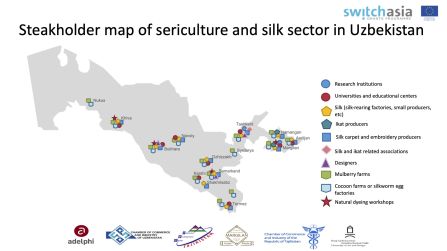Region
Central Asia is among the oldest centers of human culture. Its peoples — Kazakh, Kyrgyz, Uzbek, Karakalpak, Turkmen, Tajik — have much in common in tradition, religion, culture and life due to their common ethnic kinship and shared historical destiny. This project particularly focuses on the two countries Uzbekistan and Tajikistan.
Uzbekistan
Uzbekistan covers an area of 447 400 sq. km and has a population of 34 million. Languages which are commonly spoken are Uzbek, Russian and English. Uzbekistans capital is Tashkent. The countries natural resources are for instance: natural gas, oil, gold, silver, uranium, molybdenum, tungsten, coal, copper, zinc, etc.
As of 2018 around 18,000 tons of of mulberry silkworm cocoons were grown. The export value can be estimated around 60 million USD. The sector covers over 14,000 permanent and over 410,000 seasonal jobs. International trade relations exist with China, iran, Vietnam, India, Korea, United Arab Emirates, Turkey, Austria, Hungary, Italy, Germany, Belgium, Bulgaria, USA, Singapore, Pakistan and Kyrgyzstan.
Tajikistan
Tajikistan covers a territory of 143.1 thousand sq. km of which 93% are mountain areas. 9 million people live in the country. Languages which are commonly spoken are Tajik, Russian and English. The capital is Dushanbe. Some of the most important natural resources are coal, oil, natural gas, iron, zinc, antimony, mercury, gold, tin, tungsten, boron, table salt, fluorite, precious and semi-precious stones, aluminum. Important industries are mining, hydropower, textiles and agriculture (cotton, fruits, vegetables, silk, grain, tobacco)



